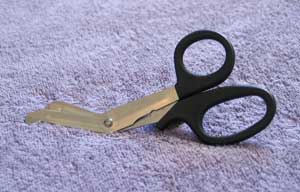Bondage is potentially very dangerous. If it's done wrong you can seriously injure and potentially even kill your partner, so pay close attention to safety.
Here are a few big "No - No's":
- Never leave a bound person alone, especially if they're gagged,
- Never play when you're tired or under the influence of drugs or alcohol
- Never tie a rope across the front of the neck
Joints - Tying on the joints themselves isn't a very good idea. Usually, when we tie the wrists or ankles, we're really tying just above the joint, on much less sensitive areas.
Blood circulation and nerves - Many of us love the idea of super-tight ropes, but the reality is that tying them too tight will quickly cut off the circulation and lead to the bottom's limbs falling asleep - no fun at all. A good test is to check that you can slide a finger or two back and forth between the bound skin and the rope.
It's also a good idea to check and make sure the ropes haven't grown tighter over time. Ropes can stretch or tighten down as the bottom struggles.
In addition to cutting off circulation, ropes pressing on nerves can also cause serious damage. If you're tied and and experiencing "bad pain" from the tightness (as opposed to "good" pain or enjoyable discomfort), let the top know so that she can adjust it and avoid potential nerve damage.
And as a top, keep an eye on the temperature and color of the subs limbs. If they're starting to turn blue or purple or are getting cold it's time to untie the bottom.
I'll admit I've had a few scares. Once when my ankles were tied tightly for a very long time, I noticed the next day that I had a small numb area on the top of my big toe. It continued on like that for the longest time and only completely went away after three months. Another time I played too hard and ended up with a sore elbow, which again lingered on for several months. These things can happen pretty easily, and the danger can often be greater when you've gained some experience and become complacent about safety, thinking it'll never happen to me.
Time limits - How long can you keep someone tied up safely? When you're first playing with someone it's best to be cautious - perhaps thirty minutes to an hour. You can often lengthen a bondage session if you change positions every so often, allowing the limbs, especially the wrists and elbows, to recover before doing the next tie.
Safewords - Always have a safeword or signal decided on beforehand to indicate if you need to be released or need to make an adjustment. When gagged I like to make the sound of an English police siren (a high and a low tone) to indicate that I need the gag removed. You can also hum a particular tune ("Happy Birthday" is a popular choice), or drop a set of keys that you hold in your hand. Having the sub make a peace sign and wave their fingers around is another possible technique, though the top has to be paying attention and be able to see the hands.
Other health concerns - Also be sure to discuss any other health concerns that you should be aware of - sensitive joints or existing medical conditions that may affect your play.
Scissors - Always have safety scissors on hand in case you need to cut someone out fast. Rope is cheap and easily replaced, so don't hesitate to cut it if there's an emergency. I bought these EMT scissors on Ebay.

Self bondage - is a controversial subject. It's inherently very risky and potentially deadly. I have to admit I find it a big turn on and I've done it many times over the years, so I'd be a hypocrite to say never do it. Besides, if you're into it, you're going to do it regardless of what I say. But If you do it, be very careful. Think things through and always have a back-up method for releasing yourself, preferably several.
Also, don't try out several new techniques all at once. Take it slow and practice your release methods. When you're turned on is not the time to decide to try something new and then later find out that you can't get free. People die every year from self bondage, usually from being unable to free themselves and then choking or vomiting into their gag. A nasty way to die and a horror for the person who finds the body.
Positional Asphyxia - In his "Erotic Bondage Handbook," Jay Wiseman talks at length about positional asphyxia - basically a situation where a person dies because the position of their body interferes with breathing. Pressure on the chest, for example, from tight ropes or from lying face-down, such as in a hogtie, can hinder breathing, so it's important to be alert for such risks during a scene. Jay Wiseman talks about cases where passing out increases the danger even further, resulting in death. Oftentimes it takes a very long time for the situation to become fatal but it's a danger to be aware of.
Fainting and Falling - Another major danger is fainting and falling. To paraphrase Jay Wiseman again, "Everything was going just fine and then they fell." Many people get hurt while tied up by losing their balance or passing out. Make sure your sub isn't famished or in a weakened state.